Understanding Black and White Wasps: Biology & Ecology
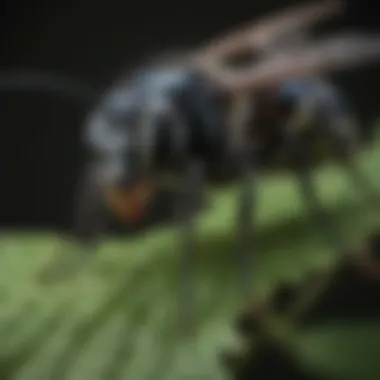
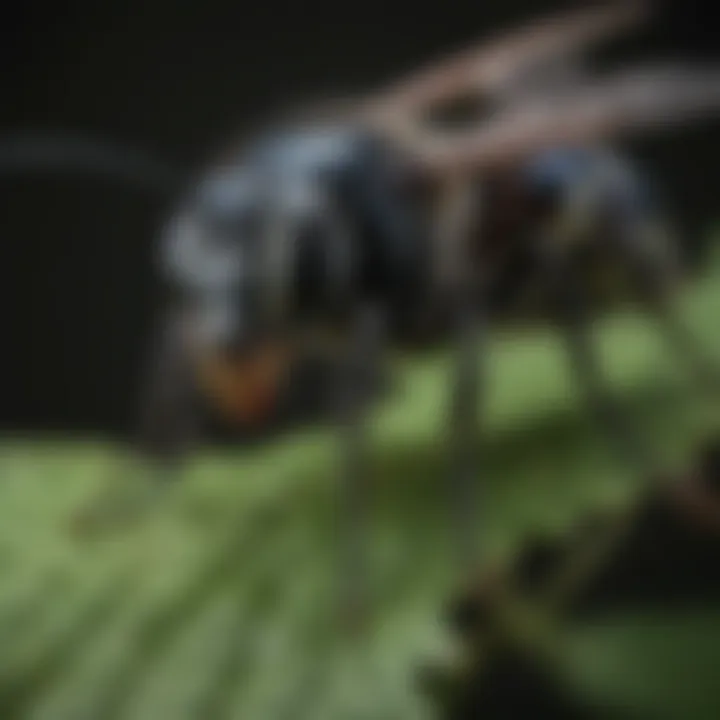
Intro
The complex interplay of living organisms within an ecosystem captivates the attention of biologists and ecologists alike. Exploring black and white wasps offers a compelling glimpse into this world. These insects, often overlooked, play vital roles in woodland ecosystems. An understanding of their biology, nesting habits, and ecological significance contributes to a broader awareness of forest health and sustainability.
Understanding Woodland Ecosystems
Woodland ecosystems represent intricate networks of flora and fauna. They support rich biodiversity, which is essential for the overall health of the planet. Black and white wasps are a key component of these environments, acting as pollinators and as part of the food web.
Importance of Biodiversity in Forests
Biodiversity within forests is crucial for ecosystem resilience. It ensures stability and enhances productivity. Here are some key points regarding the biodiversity in these habitats:
- Species Interactions: Diverse species contribute to nutrient cycling, soil health, and the reduction of pests.
- Ecosystem Services: Biodiversity helps provide essential services such as clean air and water, carbon sequestration, and habitat provision.
- Adaptability: A rich variety of species allows ecosystems to adapt to environmental changes and disturbances.
Blacks and white wasps, among many others, contribute to this intricate balance, helping maintain forest biodiversity.
Role of Forests in Climate Regulation
Forests play a critical role in regulating the Earth's climate. They act as carbon sinks, helping to mitigate the effects of climate change. Special mention should be given to the following aspects:
- Carbon Storage: Trees absorb carbon dioxide during photosynthesis, reducing greenhouse gas levels in the atmosphere.
- Microclimate Regulation: Forests help control local temperatures and humidity levels, which can influence regional climate patterns.
- Wildlife Habitat: Healthy forests support diverse species, including black and white wasps, which in turn uphold native ecosystems.
"Protection of forests is not merely an environmental issue; it's a vital step in sustaining life on Earth."
Sustainable Forestry Practices
Sustainable forestry practices are essential to maintaining the ecological balance. These strategies focus on meeting current needs without compromising the ability of future generations to meet theirs.
Principles of Sustainable Forestry
The following principles guide sustainable forestry practices:
- Forest Maintenance: Protecting the existing forest structures promotes biodiversity and keeps ecosystems functional.
- Resource Management: Efficiently managing timber resources while minimizing ecological impacts.
- Restoration Activities: Implementing strategies to restore degraded forest areas supports the return of native species, including beneficial wasps.
Case Studies of Successful Implementations
Examining real-life scenarios provides insights into effective sustainable forestry practices:
- Sweden’s Sustainable Forest Management: Sweden successfully balances timber production with environmental conservation, leading to healthy forest ecosystems.
- Sustainable Logging in Oregon: This region has implemented selective logging, preserving habitats for various species while maintaining forest health.
Woodland Stewardship Techniques
Woodland stewardship involves proactive management of forest resources to preserve their health and productivity. The following techniques are pivotal in this process.
Forest Management Plans
A well-documented forest management plan helps ensure that ecosystems remain robust. This includes:
- Assessment of Tree Species: Identify and prioritize tree species that contribute positively to ecosystem balance.
- Monitoring Biodiversity: Regular monitoring of wildlife, including wasps, assists in maintaining ecological health.
- Community Involvement: Engaging local communities in management practices fosters awareness and support for conservation efforts.
Conservation Strategies
A variety of strategies can support conservation efforts:
- Creating Protected Areas: Establishing reserves to safeguard essential habitats.
- Implementing Educational Programs: Increasing awareness among forestry professionals about the ecological roles of species like black and white wasps.
- Promoting Native Species: Encouraging the growth of native plants helps support the insects and wildlife that rely on them.
By recognizing the roles of black and white wasps within the broader context of woodland ecosystems, we can enhance our stewardship efforts and contribute to preserving these complex environments.
Prelude to Black and White Wasps
Understanding black and white wasps requires a deep dive into their biology and ecology. This section aims to lay a strong foundation for the subsequent discussions about their various aspects. Black and white wasps are often overlooked despite their significant contributions to ecosystems. They play crucial roles in pollination, pest control, and serving as a food source for other creatures. By highlighting their importance, one can begin to appreciate their role in maintaining ecological balance.
Defining Black and White Wasps
Black and white wasps belong to a diverse group of insects within the Hymenoptera order, specifically the family Vespidae. They are characterized by their distinctive coloration, which provides an immediate visual cue for identification. While various subspecies exist, they generally share common features: a slender body, relatively large eyes, and delicate wings. The black and white coloration can vary, leading to different patterns and shades depending on the species.
These wasps exhibit a wide range of behaviors and ecological roles. They can be found in various habitats, mainly woodlands, and are often mistaken for other species due to their coloration. It is important to accurately define which species we refer to, as their behaviors and ecological contributions can differ significantly.
Importance in Woodland Ecosystems
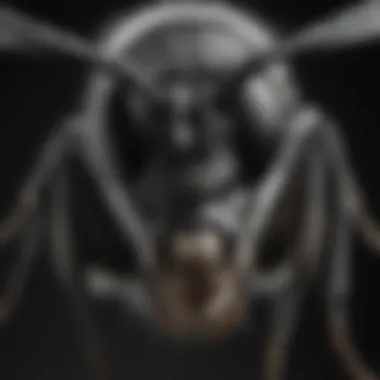
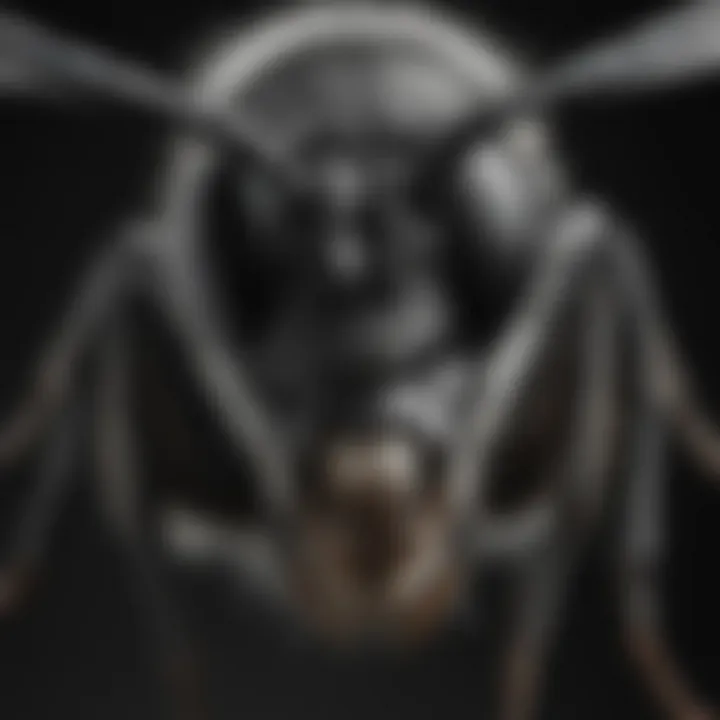
The role of black and white wasps in woodland ecosystems cannot be understated. They contribute significantly to the balance of these natural environments. Here are some key points regarding their importance:
- Pollination: Many black and white wasps participate in the pollination of flowering plants, aiding in the reproduction of diverse plant species.
- Pest Control: They help regulate pest populations by preying on various insects, thus maintaining a natural balance.
- Food Source: These wasps are vital in the food web, serving as prey for birds, mammals, and other insects. Their presence directly supports the survival of a variety of species.
"Black and white wasps exemplify the interconnectedness of woodland ecosystems by supporting both flora and fauna."
In summary, black and white wasps are not just insects; they are integral components of the woodland ecosystem. Their presence and behaviors can significantly influence ecological dynamics, making it essential for forestry professionals and academics to study them in detail. Through understanding these wasps, we enhance our capacity for effective forest management and conservation strategies.
Taxonomy of Wasps
The taxonomy of wasps is fundamental to understanding their ecological roles and biological significance. This classification system helps professionals and researchers identify various species, which is crucial for ecological studies and environmental management. By categorizing wasps into distinct groups, it becomes easier to analyze their behaviors, interactions, and contributions to woodland ecosystems. Additionally, correct classification aids in recognizing species that may be endangered or need conservation efforts.
Classification of Wasps
Wasps fall under the order Hymenoptera, which also includes bees and ants. They are typically divided into two main sub-orders: Apocrita and Symphyta. The Apocrita are further classified into several families, including Vespidae, which encompasses yellowjackets and hornets; and Sphecidae, home to the solitary wasps.
This classification is not merely academic. It has practical implications for forestry professionals. Understanding where a certain species fits within the taxonomy helps in predicting its behavior, feeding habits, and ecological impact.
- Order: Hymenoptera
- Suborder: Apocrita
- Key Families:
- Vespidae
- Sphecidae
Common traits among these families include their body structure and reproductive strategies, which vary widely among species.
Common Species of Black and White Wasps
Within the realm of black and white wasps, several species stand out due to their distinctive characteristics and ecological roles. For instance, the Polistes dominula, commonly known as the European paper wasp, is recognized for its unique nesting behavior and societal structure. Another notable species is the Acombisphecia jucunda, a solitary wasp known for its intricate burrowing habits.
Understanding these species is essential for a few reasons:
- They help control pest populations, contributing to natural pest management.
- They perform pollination, albeit to a lesser extent than bees, aiding in plant reproduction.
- Their presence indicates the health of the environment, making them useful bioindicators.
In summary, the classification of black and white wasps and an understanding of their common species provide valuable insights into their ecological significance. This knowledge is pivotal for managing and preserving their populations in diverse ecosystems.
Physical Characteristics
Understanding the physical characteristics of black and white wasps is crucial for several reasons. First, these traits aid in the identification of different species. Proper identification can inform ecological studies and pest management strategies. Furthermore, the morphological features of these wasps reveal adaptation mechanisms that enable them to thrive in their specific habitats. This section highlights the significant features that shape their lives.
Morphological Features
Morphology of black and white wasps includes various elements that define their physical structure. They typically exhibit a segmented body divided into three main parts: the head, thorax, and abdomen. Each segment plays a distinct role in their anatomy. The head houses the eyes, antennae, and mandibles, which are essential for sensory perception, communication, and feeding.
The wings are also an important aspect of their morphology. Most black and white wasps possess two pairs of wings that help them in navigating their environment efficiently. The length and structure of the wings can vary between species, influencing their flight patterns and agility. Additionally, their legs are adapted for walking and grasping, which are vital for foraging.
A closer look at their stinger, found at the end of the abdomen, indicates their role as predators. This feature is crucial not only for defense but also for capturing prey. The morphological traits of black and white wasps demonstrate how they have evolved to fit into their ecological niches effectively.
Coloration and Patterns
Coloration in black and white wasps exhibits striking contrasts. Predominantly, these wasps display a black and white pattern that serves multiple purposes. From an ecological standpoint, these colors can act as a warning to potential predators about their venomous capabilities. The distinct contrast can deter birds and other animals that might consider them as prey.
The patterns on their bodies can also vary significantly among species. Some have stripes, while others may display spots or solid colorations. These markings are not merely aesthetic; they can be vital in species recognition and mate selection during the reproductive season.
In addition to their ecological roles, coloration affects their interaction with the environment. For instance, these colors can impact how the wasps regulate their body temperature. Darker shades can absorb heat when temperatures are low, while lighter colors can reflect sunlight to keep them cool.
In summary, the physical characteristics of black and white wasps play essential roles in their identification, survival, and interaction with both predators and the environment. Directly understanding these features can inform forestry practices and conservation strategies.
Behavioral Patterns
Behavioral patterns of black and white wasps are critical to understanding their role in the ecosystem. These behaviors are diverse, including foraging habits, nesting behaviors, and social structures. By studying these aspects, we can appreciate their importance beyond mere observation. Their behaviors influence not only their populations but also those of other species within their habitats.
Foraging Habits
Foraging habits of black and white wasps entail how they search for food and resources. These wasps often show a methodical approach, which can vary between species. They primarily hunt for other insects, serving as predators that help regulate pest populations. Notably, black and white wasps are often attracted to certain flowering plants. This attraction not only provides them with nutrients but also aids in pollinating these plants.
The foraging behavior can also reflect environmental conditions. In warmer months, wasps tend to be more active, leading to increased interactions with other species. They use visual and olfactory cues to locate food sources, emphasizing their reliance on environmental signals. This efficiency in foraging is crucial for their survival and reproduction.
"Wasps contribute significantly to pest control through their foraging methods, highlighting their role in maintaining ecological balance."
Nesting Behaviors
Nesting behaviors vary widely among black and white wasps. Some species create nests in the ground, while others prefer above ground sites like trees or buildings. The construction of nests often involves the application of plant fibers mixed with saliva, forming a paper-like structure. This unique nesting technique demonstrates their adaptability and resourcefulness.
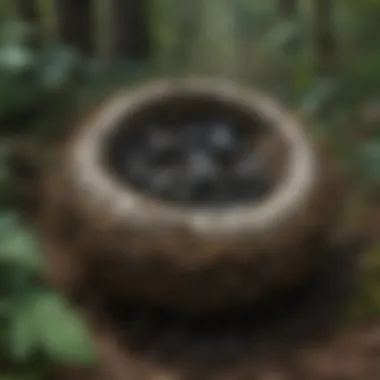

Nesting sites are chosen based on safety and resource availability. Wasps may return to the same location annually if the conditions are favorable. Understanding their nesting behaviors allows for enhanced forest management strategies, recognizing the importance of preserving nesting sites.
These behaviors also play a role in social interactions during the rearing of offspring. Nests serve as communal spaces for some species, allowing for cooperative care among females.
Social Structure
The social structure of black and white wasps can be complex. Some species exhibit solitary behavior, while others are social and live in colonies. In social species, a clear hierarchy exists, often with a queen overseeing the nest. Female workers play roles in foraging and caring for the young, thereby influencing the overall health of the colony.
The dynamics within these social structures can significantly impact population sustainability. For instance, a healthy social structure can enhance survival rates of larvae and contribute to the colony’s productivity.
Furthermore, the social behaviors observed in these wasps reflect broader ecological interactions. This complexity is important, especially in mixed ecosystems where cooperation and competition with other species define survival.
Ecological Roles
Understanding the ecological roles of black and white wasps is essential for comprehending their significance within woodland ecosystems. Their activities contribute to a balanced environment, directly affecting plant diversity and pest populations. As these wasps interact with their surroundings, they assume roles that help maintain the integrity of various ecosystems and promote biodiversity. This section delves into their contributions to pollination, pest control, and the broader food web dynamics.
Pollination Contributions
Black and white wasps are often underestimated as pollinators. While they may not be as prominent as bees, their role in pollination is noteworthy. They visit flowers searching for prey or nectar, helping transfer pollen between plants. This process is vital for many plant species, particularly those that have evolved alongside these insects. Some key points about their pollination contributions include:
- Enhancing Plant Reproduction: By facilitating cross-pollination, these wasps contribute to genetic diversity within plant populations.
- Support for Flora: Many woodland plants, particularly flowering species, depend on diverse pollinators to sustain their lifecycle. Without such interactions, plant populations may decline.
- Niche Pollinators: In certain environments, black and white wasps may serve as the primary pollinators for specific plants, indicating their unique ecological role.
Pest Control Functions
In addition to their pollination efforts, black and white wasps play a significant role in pest control. They are natural predators of many insect species that can be detrimental to plant life. Their hunting behaviors help regulate pest populations, reducing the need for chemical pesticides in forestry management. Key aspects of their pest control functions include:
- Biological Pest Management: These wasps hunt various herbivorous insects, preventing them from becoming a significant threat to plant health.
- Predation Impact: By maintaining populations of certain pests, black and white wasps contribute to ecological balance, allowing native plant species to thrive.
- Support for Other Species: Their predatory behavior may also enhance conditions for other insectivorous organisms, creating a more resilient and diverse ecosystem.
Food Web Dynamics
The presence of black and white wasps influences food web dynamics within their habitats. They occupy specific niches as both predators and prey, playing a crucial role in the energy transfer among various trophic levels. Important points to consider include:
- Trophic Interactions: As predators, black and white wasps compete with other species for food resources, thereby influencing their population dynamics.
- Nutrient Cycling: Their predation supports nutrient cycling, which is essential for maintaining soil health and plant productivity.
- Indicated Biodiversity: The abundance of black and white wasps can indicate the overall health of an ecosystem, reflecting the balance between predators and their prey.
In summary, black and white wasps occupy integral roles in their ecosystems, fostering relationships that sustain plant diversity, control pest populations, and contribute to food web structure. Their ecological importance cannot be overstated, particularly in light of ongoing environmental changes.
Habitat and Distribution
Understanding the habitat and distribution of black and white wasps is crucial for recognizing their ecological roles. The chosen environments significantly affect their behavior, reproductive success, and interactions with other species. Mapping their habitats allows ecologists to assess biodiversity and conservation needs effectively.
Preferred Habitats
Black and white wasps exhibit a variety of habitat preferences, often depending on specific ecological requirements. These wasps are commonly found in:
- Woodlands: They thrive in deciduous and mixed forests where they find abundant food sources and suitable nesting sites.
- Meadows: Open grasslands provide essential resources for foraging, especially for prey.
- Urban Gardens: Surprisingly, some species adapt well to urban environments, utilizing the floral diversity offered in gardens and parks.
- Scrubland: Contains a mixture of vegetation types, which offers shelter and foraging opportunities.
Their habitats are generally characterized by a mix of vegetation and open spaces, which facilitate their foraging and nesting behaviors. These settings are essential for their survival and reproduction, as they rely on both plant and insect availability.
Global Distribution Patterns
The global distribution of black and white wasps is influenced by climatic and geographical factors. They inhabit various regions across multiple continents, with noticeable variations in species diversity. Key distribution details include:
- Temperate Regions: These areas, particularly in Europe and North America, host a wide variety of black and white wasp species.
- Tropical Areas: Some species adapt to the humid conditions, leading to higher biodiversity but also more competition.
- Subarctic Luands: Here, their presence is less common, often limited by temperature extremes and availability of food resources.
Studies indicate that climate change may alter the distribution of these insects. As temperatures rise, some populations may shift northward, impacting ecosystems they leave behind. Monitoring their distribution is essential for understanding broader ecological changes and related conservation efforts.
"Habitat loss and climate change greatly influence the distribution of many wasp species, causing ecological imbalances."
Threats and Conservation
Threats to black and white wasps are significant and stem primarily from human activities. Identifying these threats alongside effective conservation strategies is essential to safeguard their populations and, consequently, the woodland ecosystems they support. Addressing the challenges faced by these wasps is not just about preserving one species, but about maintaining the intricate balance of biodiversity in their habitats.
Human Impacts on Populations
Human activities present a range of challenges to the population of black and white wasps. Habitat destruction remains one of the most pressing issues. Urban development, agricultural expansion, and deforestation lead to the loss of nesting sites and food sources. Pesticides and herbicides used in farming can be particularly lethal, not only reducing wasp populations directly but also disrupting the overall ecosystem by eliminating the prey species they rely on.
Pollution is another significant concern. Contaminated water and soil negatively affect the flora that these wasps depend on. Changes to the climate also play a role. Increasing temperatures and altered rainfall patterns can affect the availability of resources, forcing wasps to adapt or relocate, which may not always be successful.
Moreover, the introduction of non-native species can create competition for food and nesting sites. This dynamic can displace black and white wasps, reducing their numbers and disrupting their social structures. In summary, human influences such as habitat destruction, pesticide use, pollution, climate change, and species invasions are critical threats that must be continuously monitored and addressed.
Conservation Strategies
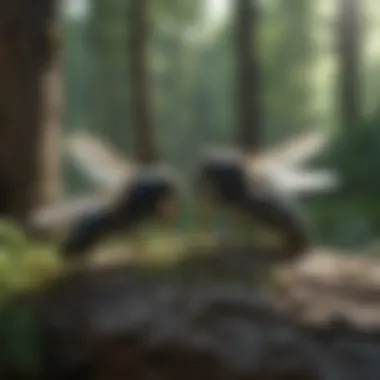

To conserve black and white wasps, a multifaceted approach is necessary.
Habitat Protection and Restoration
Protecting existing habitats is vital. This involves establishing protected areas where these wasps can thrive without the pressures of human encroachment. Restoration initiatives can rehabilitate degraded habitats, ensuring there are sufficient natural resources available for these wasps.
Sustainable Agricultural Practices
Adopting more sustainable agricultural practices can lessen the impact of pesticides on wasp populations. Integrated Pest Management (IPM) strategies can help control pests without harming beneficial species, such as wasps. Farmers and agricultural workers should be educated on the importance of these wasps as natural pest controllers.
Community Engagement and Education
Building awareness among local communities about the ecological significance of black and white wasps is crucial. Engaging locals in citizen science projects can foster a connection to these insects while collecting valuable data on their populations and behaviors. Schools and community groups can help in raising awareness about the role of wasps in pollination and pest control.
Research Initiatives
Finally, continued research is necessary to monitor black and white wasp populations and their health. Studies should focus on understanding their ecology, behavior, and responses to environmental changes. >
„Understanding the threats faced by black and white wasps is the first step towards effective conservation strategies.”
Research and Studies
Research and studies regarding black and white wasps play a crucial role in understanding their biology and ecological significance. Investigating these species contributes to our knowledge of woodland ecosystems and the interdependence of various organisms.
The primary benefit of researching black and white wasps is the insights gained into their behavior, habitat preferences, and ecological roles. Such studies can lead to better conservation strategies and management practices aimed at preserving their populations. Additionally, understanding their interactions with other species helps us recognize their importance in pest control and pollination, both essential for a balanced ecosystem.
Considering the varied habitats where these wasps reside, research also helps to identify specific environmental factors that influence their distribution and survival. This aspect is particularly vital in the context of changing climate patterns and habitat destruction.
Recent Findings on Black and White Wasps
Recent scientific studies have uncovered significant findings about black and white wasps, particularly their nesting behavior and social structures. For instance, research indicates a preference for nesting sites in hollows and crevices, underlining their adaptability to different environments. These studies highlight that while many wasps are solitary, some black and white species exhibit social tendencies, showcasing complex interactions within their colonies.
Moreover, there have been discoveries regarding their foraging habits. Recent research indicates a reliance on diverse nutritional sources, which makes them effective pollinators. This is particularly important in maintaining the health of various native plant species, suggesting a more intricate role in their ecosystems than previously understood.
Ongoing Research Initiatives
Ongoing research initiatives strive to further illuminate the biology of black and white wasps. Current projects focus on mapping their global distribution using modern technology, such as GIS tools. These methods allow researchers to track population dynamics and assess the impacts of environmental changes more efficiently.
Another prominent research area is the investigation of their role in pest control. Scientists are examining how black and white wasps contribute to reducing pest populations, affecting forest health and crop yields significantly. Such studies are vital for integrating sustainable practices in forestry management.
In addition to ecological studies, some initiatives explore the genetic diversity of black and white wasps. Insights from genetic research can help in understanding adaptability and resilience against environmental stresses. This information is essential for conservation efforts, as it aids in developing strategies tailored to protect these wasps and their habitats.
Understanding black and white wasps provides vital information that can enhance ecosystem management and contribute to biodiversity preservation.
Implications for Forestry Practices
Understanding the implications of black and white wasps in forestry is crucial for sustainable forest management. These wasps, often overlooked, hold significant roles that can enhance forest health and biodiversity. Their presence indicates a well-balanced ecosystem, and recognizing their contributions can lead to better forestry practices.
Integrating Wasps into Forest Management
Integrating black and white wasps into forest management involves acknowledging their ecological roles. Wasps can be effective in controlling pest populations. Utilizing their natural behaviors in integrated pest management (IPM) can reduce the need for chemical pesticides. This method not only lowers cost but also fosters a more balanced environment.
Here are a few considerations for integration:
- Habitat Preservation: Maintaining natural habitats that support wasp populations is critical. This might include leaving dead wood and allowing undergrowth to flourish, providing essential nesting sites.
- Monitoring Populations: Regularly assessing wasp populations can inform management decisions. Understanding population dynamics allows foresters to adjust practices to benefit both trees and wasps.
- Collaboration with Ecologists: Working closely with specialists can help in developing strategies that utilize wasps effectively. This synergy can yield intelligent solutions within forestry practices.
Promoting Biodiversity through Conservation
Conserving black and white wasps is part of promoting overall biodiversity in forest ecosystems. Biodiversity underpins ecosystem functionality, improving resilience against diseases and climate change. The following points highlight significance of wasps in this context:
- Enhancing Ecosystem Function: Black and white wasps contribute to pest control, which in turn supports plant health. A diverse ecological community can lead to increased crop yields and forest productivity.
- Encouraging Natural Balance: By enabling the presence of wasps, forests can achieve a natural balance. This can prevent pest populations from exploding, reducing reliance on artificial interventions.
- Educational Opportunities: Promoting awareness about the value of wasps can aid conservation efforts. Engaging communities in conservation activities fosters a sense of responsibility towards woodland ecosystems.
Maintaining the ecological relationships between black and white wasps and their environment is key to creating sustainable forestry practices.
Incorporating black and white wasps in forestry management not only benefits the wasps but also supports broader ecological integrity. By taking proactive steps in conservation and habitat management, forestry professionals can ensure a healthier and more balanced ecosystem.
The End
The conclusion of this article serves as a synthesis of the essential insights gathered throughout the exploration of black and white wasps’ biology and ecology. It emphasizes the intricate connections these wasps have within woodland ecosystems and their overall importance in maintaining ecological balance. Understanding their roles reveals how they contribute significantly to pollination, pest control, and food web dynamics. This knowledge is particularly valuable for forestry professionals who strive to integrate ecological perspectives into their management strategies.
Moreover, recognizing the threats these wasps face due to human activities is crucial for developing effective conservation measures. By focusing on the significance of preserving their habitats, this article underscores the necessity of an informed approach that highlights the value of biodiversity in forest ecosystems.
Summary of Key Insights
In reviewing the behavior, habitat, and ecological roles of black and white wasps, several key insights emerge:
- Biological Diversity: Black and white wasps display a range of morphological features and behaviors that illustrate their adaptability and ecological significance.
- Ecosystem Contributions: Their roles in pollination and pest control exemplify their importance for maintaining healthy forest dynamics.
- Sensitivity to Change: The impact of habitat loss and climate change on their populations highlights the fragility of these wasps’ existence.
Future Directions for Research
Future research initiatives should prioritize understanding the specific interactions between black and white wasps and their environment. Areas of focus could include:
- Behavioral Ecology: Investigating how changing environmental conditions affect their foraging and nesting habits.
- Population Studies: Long-term monitoring of wasp populations can provide insight into their resilience against anthropogenic pressures.
- Conservation Strategies: Developing targeted conservation programs that incorporate findings about their ecological roles could enhance habitat management practices.
By addressing these areas, researchers can contribute to a deeper understanding of black and white wasps and ensure their continued presence in our ecosystems.







